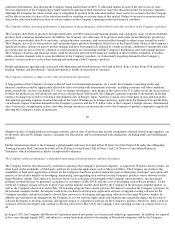Apple 2002 Annual Report Download - page 33
Download and view the complete annual report
Please find page 33 of the 2002 Apple annual report below. You can navigate through the pages in the report by either clicking on the pages listed below, or by using the keyword search tool below to find specific information within the annual report.
consistent with industry data showing the Company losing market share in the U.S. education market in each of the last two fiscal years.
Several competitors of the Company have either targeted or announced their intention to target the education market for personal computers.
Although the Company has taken certain steps to strengthen its position in the education market, there can be no assurance that the Company
will be able to increase its share of the education market or maintain its existing share of that market. Failure to increase or maintain market
share in the education market may have an adverse impact on the Company's operating results and financial condition.
The Company's future operating performance is dependent on the performance of distributors and other resellers of the Company's products.
The Company distributes its products through wholesalers, resellers, national and regional retailers and cataloguers, many of whom distribute
products from competing manufacturers. In addition, the Company also sells many of its products and resells certain third-party products in
most of its major markets directly to end users, certain education customers, and certain resellers through its online stores around the world.
The Company also sells its own products and certain third-party products through its retail stores in the United States. Many of the Company's
significant resellers operate on narrow product margins and have been negatively affected by current economic conditions. Considerable trade
receivables that are not covered by collateral or credit insurance are outstanding with the Company's distribution and retail channel partners.
The Company's business and financial results could be adversely affected if the financial condition of these resellers weakened, if resellers
within consumer channels were to cease distribution of the Company's products, or if uncertainty regarding demand for the Company's
products caused resellers to reduce their ordering and marketing of the Company's products.
Further information regarding risks associated with Marketing and Distribution may be found in Part I, Item 1 of this Form 10-K under the
heading "Markets and Distribution," which information is hereby incorporated by reference.
The Company's business is subject to the risks of international operations.
A large portion of the Company's revenue is derived from its international operations. As a result, the Company's operating results and
financial condition could be significantly affected by risks associated with international activities, including economic and labor conditions,
political instability, tax laws (including U.S. taxes on foreign subsidiaries), and changes in the value of the U.S. dollar versus the local currency
in which the products are sold and goods and services are purchased. Historically, the Company's primary exposure to movements in foreign
currency exchange rates relate to non-dollar denominated sales in Europe, Japan, Australia, Canada, and certain parts of Asia and non-dollar
denominated operating expenses incurred throughout the world. Weaknesses in foreign currencies, particularly the Japanese Yen and the Euro,
can adversely impact consumer demand for the Company's products and the U.S. dollar value of the Company's foreign currency denominated
sales. Conversely, strengthening in these and other foreign currencies can increase the cost to the Company of product components, negatively
affecting the Company's results of operations.
40
Margins on sales of Apple products in foreign countries, and on sales of products that include components obtained from foreign suppliers, can
be adversely affected by foreign currency exchange rate fluctuations and by international trade regulations, including tariffs and antidumping
penalties.
Further information related to the Company's global market risks may be found in Part II, Item 7A of this Form 10-K under the subheading
"Foreign Currency Risk" and may be found in Part II, Item 8 of this Form 10-K at Notes 1 and 2 of Notes to Consolidated Financial
Statements, which information is hereby incorporated by reference.
The Company's future performance is dependent upon support from third-party software developers.
The Company believes that decisions by customers to purchase the Company's personal computers, as opposed to Windows-based systems, are
often based on the availability of third-party software for particular applications such as Microsoft Office. The Company also believes the
availability of third-party application software for the Company's hardware products depends in part on third-party developers' perception and
analysis of the relative benefits of developing, maintaining, and upgrading such software for the Company's products versus software for the
larger Windows market. This analysis is based on factors such as the perceived strength of the Company and its products, the anticipated
potential revenue that may be generated, acceptance by customers of Mac OS X, and the costs of developing such software products. To the
extent the Company's financial losses in prior years and the minority market share held by the Company in the personal computer market, as
well as the Company's decision to end its Mac OS licensing program, have caused software developers to question the Company's prospects in
the personal computer market, developers could be less inclined to develop new application software or upgrade existing software for the
Company's products and more inclined to devote their resources to developing and upgrading software for the larger Windows market. In
addition, past and future development by the Company of its own software applications and solutions may negatively impact the decision of
software developers to develop, maintain, and upgrade similar or competitive software for the Company's products. Moreover, there can be no
assurance software developers will continue to develop software for Mac OS X, the Company's new operating system, on a timely basis or at
all.
In August 1997, the Company and Microsoft Corporation entered into patent cross license and technology agreements. In addition, for a period
of five years through August 2002, and subject to certain limitations related to the number of Macintosh computers sold by the Company,
























